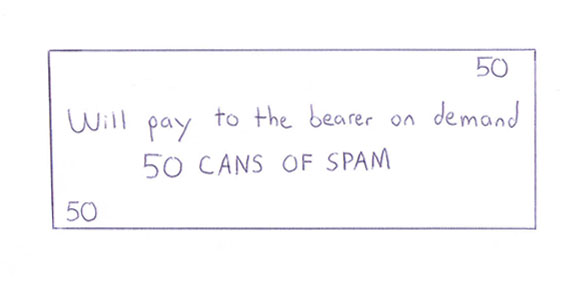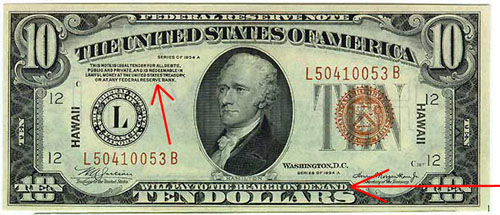|
With a deep passion for learning and knowledge, Chris is an avid enthusiast of mathematics, computer science, physics, philosophy of mind, and economics.
If you have any questions or comments about what you read on this website, feel free to email him at: NoSpam@ChristopherLind.Com (Replace NoSpam with Chris)
|
Article: The origin of Banks and Paper Money. 6-18-2005
Previous Artice: What is Money? Part I: The origin of Money
What is Money? Part II: The origin of Banks and Paper Money.
This article picks up with the hypothetical example from the first article, where
cans of spam have emerged in a market as a commodity money.
Let's say you're a successful business owner, and through hard work and shrewd business
deals, have amassed a small fortune in money...50 cans of spam!
You don't want to worry about thieves breaking into your house and stealing your
spam, so you take your spam to a warehouse for safekeeping. The warehouse charges
you a small annual fee for their services.
The warehouse gives you a receipt for the spam you have deposited with them.
This receipt has the words, "Will pay to the bearer on demand 50 cans of spam".

At this point, your 50 cans of spam have been completely removed from circulation,
under lock and key in a warehouse. In place of the cans of spam, you now have
a paper receipt, which you can present to the warehouse at any time for your spam.
The warehoue has been in business for quite some time. People know from experience that
the items they deposit at the warehouse will still be there months or years down the
road when they need them again. The warehouse has a reputation of trustworthiness in
the community.
The next day, you happen to see a television set worth 50 cans of spam that you'd like
to buy. You start to head down to the warehouse to redeem your cans of spam, but
then stop, struck with a sudden thought.
Perhaps the television owner would be willing to accept the warehouse receipt as
payment for the television. The television owner could then take the receipt to
the warehouse at their leisure and redeem the receipt for the cans of spam.
The television owner agrees! You pay the former owner of the television your 50 cans
of spam paper receipt, and they give you the television.
Paper money has just been born.
This type of money is called Receipt money, because it is literally a receipt, or
certificate, for a tangible physical good that exists.
There are 2 factors which will cause the entire community to soon accept paper receipt
money in their day to day business deals.
These factors are:
1) Convenience. It is much easier to carry around a piece of paper than 50 cans of spam
or 5 pounds of silver.
2) Trustworthiness. The community trusts that the paper reciept or certificate actually
represents the tangible good printed on the paper. In the previous example, if the
television owner suspected that the reciept would not be able to be redeemed for the
50 cans of spam, no trade would have taken place.
Below are pictures of money used in the United States with the words "Will pay
to the bearer on demand" printed on it. The first is picture is a picture
of a $10 dollar bill from 1941. The second is a picture of a $5.00 bill from
1950, only 55 years ago!

Federal Reserve Note. 1941.

Federal Reserve Note. 1950.
Next: The origins of Banks and Paper Money
|
|